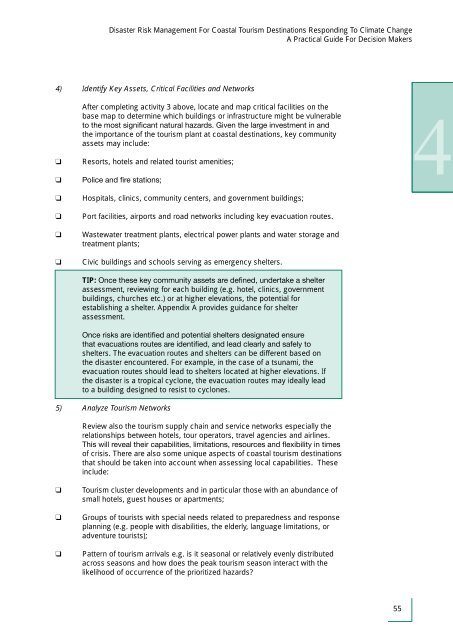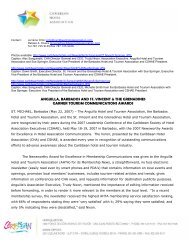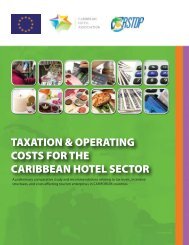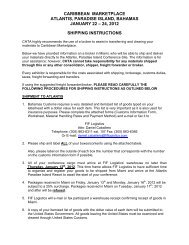Disaster Risk Management for Coastal Tourism - Caribbean Hotel ...
Disaster Risk Management for Coastal Tourism - Caribbean Hotel ...
Disaster Risk Management for Coastal Tourism - Caribbean Hotel ...
You also want an ePaper? Increase the reach of your titles
YUMPU automatically turns print PDFs into web optimized ePapers that Google loves.
<strong>Disaster</strong> <strong>Risk</strong> <strong>Management</strong> For <strong>Coastal</strong> <strong>Tourism</strong> Destinations Responding To Climate Change<br />
A Practical Guide For Decision Makers<br />
4) Identify Key Assets, Critical Facilities and Networks<br />
<br />
<br />
<br />
<br />
<br />
<br />
After completing activity 3 above, locate and map critical facilities on the<br />
base map to determine which buildings or infrastructure might be vulnerable<br />
<br />
the importance of the tourism plant at coastal destinations, key community<br />
assets may include:<br />
Resorts, hotels and related tourist amenities;<br />
<br />
Hospitals, clinics, community centers, and government buildings;<br />
Port facilities, airports and road networks including key evacuation routes.<br />
Wastewater treatment plants, electrical power plants and water storage and<br />
treatment plants;<br />
Civic buildings and schools serving as emergency shelters.<br />
TIP: <br />
assessment, reviewing <strong>for</strong> each building (e.g. hotel, clinics, government<br />
buildings, churches etc.) or at higher elevations, the potential <strong>for</strong><br />
establishing a shelter. Appendix A provides guidance <strong>for</strong> shelter<br />
assessment.<br />
<br />
<br />
shelters. The evacuation routes and shelters can be different based on<br />
the disaster encountered. For example, in the case of a tsunami, the<br />
evacuation routes should lead to shelters located at higher elevations. If<br />
the disaster is a tropical cyclone, the evacuation routes may ideally lead<br />
to a building designed to resist to cyclones.<br />
4<br />
5) Analyze <strong>Tourism</strong> Networks<br />
Review also the tourism supply chain and service networks especially the<br />
relationships between hotels, tour operators, travel agencies and airlines.<br />
<br />
of crisis. There are also some unique aspects of coastal tourism destinations<br />
that should be taken into account when assessing local capabilities. These<br />
include:<br />
<br />
<br />
<br />
<strong>Tourism</strong> cluster developments and in particular those with an abundance of<br />
small hotels, guest houses or apartments;<br />
Groups of tourists with special needs related to preparedness and response<br />
planning (e.g. people with disabilities, the elderly, language limitations, or<br />
adventure tourists);<br />
Pattern of tourism arrivals e.g. is it seasonal or relatively evenly distributed<br />
across seasons and how does the peak tourism season interact with the<br />
likelihood of occurrence of the prioritized hazards?<br />
55








